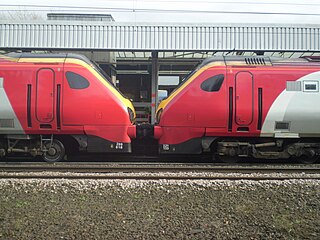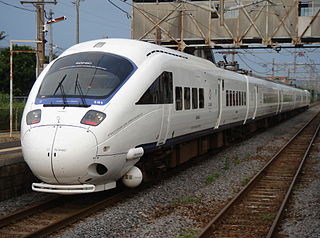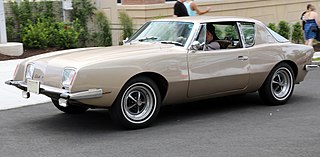
The Ford GT40 is a high-performance mid-engined racing car originally designed and built for and by the Ford Motor Company to compete in 1960s European endurance racing. Its specific impetus was to best Scuderia Ferrari, which had won the prestigious 24 Hours of Le Mans race for six years running from 1960 to 1965. Around 100 cars have been made, mostly as 289 cu in (4.7 L) V8-powered Mk Is, some sold to private teams or as road legal Mk III cars. Racing started in 1964, with Ford winning World Championships categories from 1966 to 1968. The first Le Mans win came in 1966 with three 427 cu in (7.0 L) powered Mk.II prototypes crossing the finish line together, the second in 1967 by a similarly powered highly modified US-built Mk.IV "J-car" prototype. In order to lower ever-higher race top speeds, a rule change from 1968 onwards limited prototypes to 3.0 litre Formula 1 engines; a loophole, however, allowed the private JW "Gulf Oil" team win at Le Mans in 1968 and 1969 running a Mk.I with a 5.0 litre engines.

Studebaker was an American wagon and automobile manufacturer based in South Bend, Indiana, with a building at 1600 Broadway, Times Square, Midtown Manhattan, New York City. Founded in 1852 and incorporated in 1868 as the Studebaker Brothers Manufacturing Company, the firm was originally a coachbuilder, manufacturing wagons, buggies, carriages and harnesses.

Piaggio Aerospace, formerly known as Piaggio Aero Industries, is a multinational aerospace manufacturing company headquartered in Villanova d'Albenga, Italy. The company designs, develops, manufactures and maintains aircraft, aero-engines, aerospace components and aerostructures.

The AC Cobra, sold in the United States as the Shelby Cobra and AC Shelby Cobra, is a sports car manufactured by British company AC Cars, with a Ford V8 engine. It was produced intermittently in both the United Kingdom and later the United States since 1962.

Personal luxury car is a North American car classification describing somewhat sporty, sophisticated mass-market coupés that emphasized comfort over performance. The North American manufacturers most often combined engineering, design, and marketing to develop upscale, distinctive "platform sharing" models that became highly profitable.

The Piaggio P.180 Avanti is an executive/VIP light transport aircraft, designed by Piaggio Aero and built in Italy. It features twin, wing-mounted turboprop engines, in a pusher configuration. The Avanti seats up to nine people in a pressurized cabin and may be flown by one or two pilots. The design is of three-surface configuration, having both a small forward wing and a conventional tailplane, as well as its main wing, with the main wing spars passing behind the passenger cabin area. The FAI lists it as the fastest propeller-driven aircraft with speed of 927.4 km/h.

The Ford GT is a mid-engine two-seater sports car manufactured and marketed by American automobile manufacturer Ford for the 2005 model year in conjunction with the company's 2003 centenary. The second generation Ford GT became available for the 2017 model year.

The Studebaker Avanti is a personal luxury coupe manufactured and marketed by Studebaker Corporation between June 1962 and December 1963. A halo car for the maker, it was marketed as "America's only four-passenger high-performance personal car."

Alvis Car and Engineering Company Ltd was a British manufacturing company in Coventry from 1919 to 1967. In addition to automobiles designed for the civilian market, the company also produced racing cars, aircraft engines, armoured cars and other armoured fighting vehicles.

The Studebaker Wagonaire was a station wagon produced by the Studebaker Corporation of South Bend, Indiana, from 1963–1966. It featured a retractable sliding rear roof section that allowed the vehicle to carry items that would otherwise be too tall for a conventional station wagon of the era.

The British Rail Class 221 Super Voyager is a class of tilting diesel-electric multiple unit express passenger trains built in Bruges, Belgium and Wakefield, by Bombardier Transportation in 2001–02.

Studebaker of Canada Ltd. was the name given to Studebaker Corporation's Canadian manufacturing arm.

Automotive design is the process of developing the appearance of motor vehicles, including automobiles, motorcycles, trucks, buses, coaches, and vans.

The Toyota Mark X is a mid-size car manufactured by Toyota between 2004 and 2019, and was primarily aimed at the Japanese market. The Mark X was introduced in 2004 and is the successor to the Mark II which was first introduced in 1968, and was known in the North American market as the Corona Mark II starting in 1972, and renamed the Cressida from 1977 to 1992.

The Bombardier Voyager is a family of high-speed 125 mph diesel-electric multiple units built in Belgium by Bombardier Transportation, for service on the railway network of the United Kingdom. Construction of the Voyager family took place between 2000 and 2005, consisting of three classes - the Class 220 Voyager, the Class 221 Super Voyager and the Class 222 Meridian.

Superformance LLC is an American automobile company that builds, designs, develops, engineers and markets sports cars, related performance components and full replicars. The company was founded as "Superformance International Inc." by Hi-Tech Automotive Ltd. in 1996. Today, Superformance has 15 authorized dealers in the United States and 6 international dealers. SPF cars are sold as "turnkey-minus replacers". In December, 2005 Hi-Tech Automotive transferred the ownership of its subsidiary, Superformance, to American Hillbank Automotive Group, which is a privately owned business of American entrepreneur Lance Stander. Hi-Tech Automotive continue to build Superformance cars at its plant in Port Elizabeth, South Africa.

The Hitachi A-train is a family of rail rolling stock built and designed by Hitachi Rail using a common base and construction techniques. The stock is designed to facilitate a number of product life-cycle improvements including ease of manufacture, increased energy efficiency, and recyclability.

The Avanti is an American performance sports coupe based on the Studebaker Avanti and marketed through a succession of five different ownership arrangements between 1965 and 2006.

The DC Avanti is a coupe styled sports car produced by DC Design, an Indian design firm originally headed by Dilip Chhabria. Its name was based on the Studebaker Avanti. It was unveiled at the 2012 Auto Expo in New Delhi. The Avanti is powered by 2.0-litre four-cylinder turbocharged petrol engine producing 250 bhp with a six-speed manual transmission. A limited edition model launched in 2015 comes with 310 bhp output and paddle shifters.

The British Rail Class 807 Evero is a type of electric multiple unit being built by Hitachi Rail for train operator Avanti West Coast. Based on the Hitachi A-train design, a total of 10 seven-car units will be produced.



















